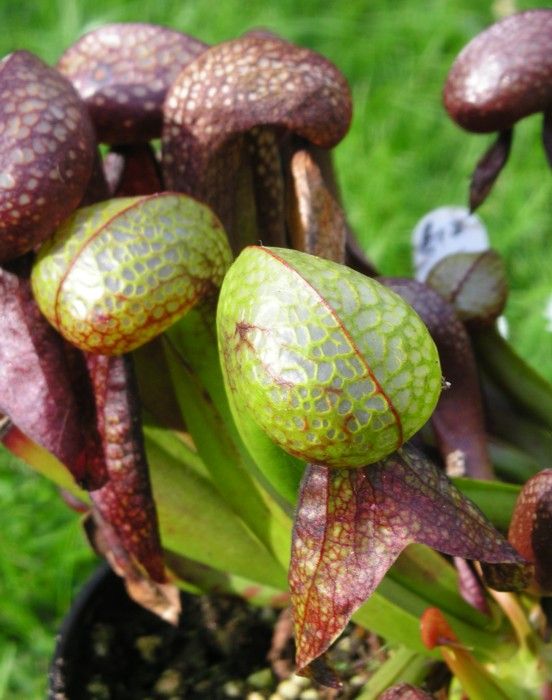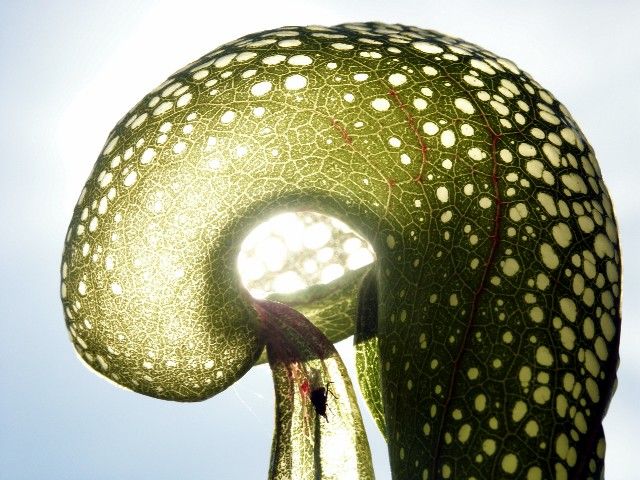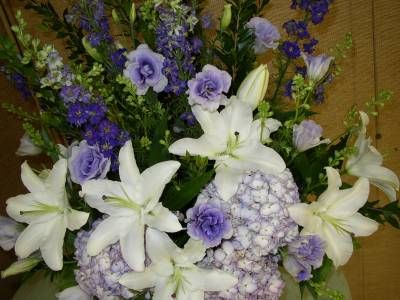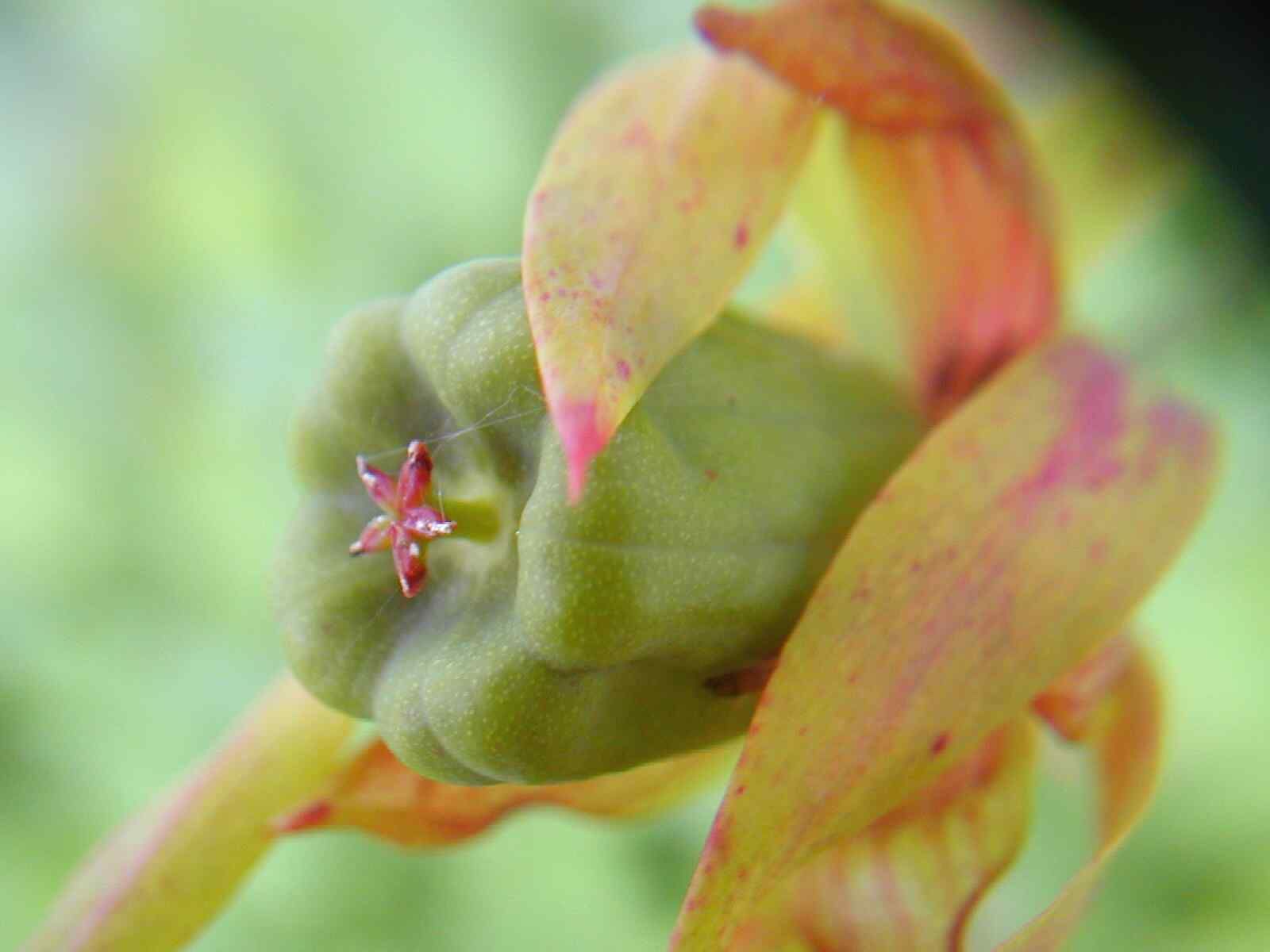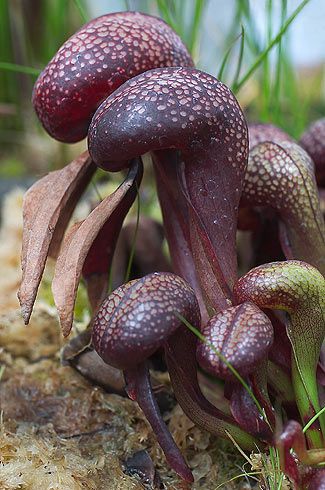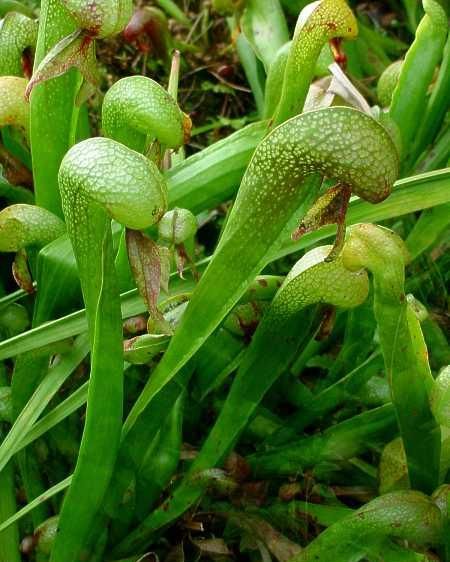Darlingtonia californica
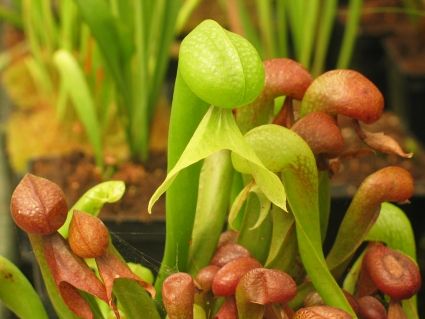
Synonims: Chrysamphora californica
Common name: California pitcher plant, cobra plant, California pitcher, cobra lily
Family: Sarraceniaceae
Origin: California and Oregon, USA
|
|
|
Description
The cobra lily is unique among the three genera of North American pitcher plants in two ways. First, it does not trap rainwater in its pitcher. Instead, it regulates the level of water inside manually by releasing or absorbing water into the trap that has been pumped up from the roots. Second, it doesn't produce any digestive enzymes. The cells that absorb nutrients from the inside of the pitcher are the same as those on the roots that absorb soil nutrients. Instead, the pitcher plant relies on symbiotic bacteria and protozoa to break down the captured insects into easily absorbed nutrients.
In addition to the use of lubricating secretions and downward-pointing hairs common to all pitcher plants to force their prey into the trap, this species carefully hides the tiny exit hole from trapped insects by curling it underneath and offering multiple translucent false exits. Upon trying many times to leave via the false exits, the insect will tire and fall down into the trap. The slippery walls and hairs prevent the trapped prey from escaping. The only other species that utilizes this technique is the Parrot Pitcher Plant, Sarracenia psittacina'.
A remaining mystery surrounding the cobra lily is its means of pollination. Its flower is unusually shaped and complex, typically a sign of a close pollinator-plant specialization, but none have been identified. The flower is yellowish purple in color and grows on a stalk with a similar length to the stalk. It has five sepals, green in color, which are longer then the red-veined petals. While pollination has not yet been observed in action, it is generally expected that the pollinator is either a fly attracted to the flower's unpleasant smell or some nocturnal insect, as no extensive study has been performed to observe potential nighttime pollinators.
|
|
|
Care and cultivation
Cobra lilies can be one of the most difficult carnivorous plants to keep in captivity, but this depends on the area in which they are cultivated. They prefer cool to warm daytime temperatures and cold/cool nighttime temperatures. The problem is that cobra lilies typically grow in bogs or streambanks that are fed by cold mountain water, and grow best when the roots are kept cooler than the rest of the plant. It is best to mimic these conditions in cultivation, and water the plants with cold, purified water. On hot days, it helps to place ice cubes of purified water on the soil surface. They prefer sunny conditions if in a humid, warm location, and prefer part-shade if humidity is low or fluctuates often. Plants can adapt to low humidity conditions, but optimum growth occurs under reasonable humidity.
|
|
|
Growing cobra lilies from seed is extremely slow and cobra seedlings are difficult to maintain, so these plants are best propagated from the long stolons they grow in late winter and spring. When a baby cobra plant is visible at the end of the stolon (ususally in mid to late spring), the whole stolon may be cut into sections a few inches long, each with a few roots attached. Lay these upon cool, moist, shredded long-fibered sphagnum moss and place in a humid location with bright light. In many weeks, baby cobra plants will protrude from each section of stolon.
Like many other carnivorous plants, cobra lilies require a cold winter dormancy in order to live long-term. Plants die down to their tubers in frigid winters and will maintain their leaves in cool winters during their dormancy period. This period lasts from 3 to 5 months during the year, and all growth stops. As spring approaches, mature plants may send up a single, nodding flower, and a few weeks later the plant will send up a few larger-than-average pitchers. The plant continues producing pitchers throughout summer, however much smaller than the start-of-season pitchers.
Many carnivorous plant enthusiasts have succeeded in cultivating these plants, and have developed three new color morphs: all green, all red, and red-green bicolor.
Wild type plants are all green in moderate light and bicolor in intense sunlight.
Info
- California pitcher plant is listed as threatened in the Family Lists of Candidate Endangered and Threatened Plant Species in the Continental United States (Smithsonian Institution 1975).
- The plant was discovered in 1841 by the botanist William D. Brackenridge at Mount Shasta. In 1853 it was described by John Torrey, who named the genus Darlingtonia after a friend.
Articole asemănătoare
-
Aesculus carnea sau castanul rosu
Pe buna dreptate, este considerat unul dintre cei mai ornamentali arbori din toata lumea, datorita frunzisului, dar mai ales florilor de culoare rosie, ce apar in numar foarte mare in ciorchini verticali asemeni unor candelabre si care persista din mai pana in iunie.
-
Scutellaria costaricana. Mirajul florilor exotice.
In America Centrala in gradina, la noi planta de interior. Rezista la temperaturile ridicate din vara cu conditia sa se afle intr-un spatiu usor umbrit si sa dispuna de umiditate atmosferica suficienta.
-
Darlingtonia californica
Denumire populara: planta cobra. Familie: Sarraceniaceae. Darlingtonia californica (planta cobra) este o planta carnivora foarte greu de mentinut in captivitate...
-
Flori care tolereaza caldura (1)
Daca plantele perene din gradina incep sa se ofileasca imediat ce incepe vara, atunci aveti nevoie de un plan pentru a face straturile sa fie mereu in floare. Incercati sa plantati intre plantele perene si plante anuale care iubesc caldura...
